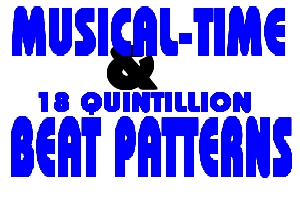|
Now I must introduce you to a new word. The word is PERMUTATE, and
that is what we are going to do to the poor little rock beat and all the other
basic dance beats as well. The dictionary defines the word "PERMUTATE"
primarily as:
For drummers, the "set of things" is the way we vary the snare or bass
drum against the cymbal rhythm. Simply put, the number of cymbal notes in
the measure will tell us precisely how many variation possibilities
(permutations) exist per measure in that particular basic dance beat pattern.
This means that virtually any measure of any piece of music will contain a
specific number of variation possibilities based on the STEADY cymbal note
"flow" (aka; secondary pulse.) We may assign each variation possibility
a logical number name on a chart that I will explain in a moment.
. ARE YOU CONFUSED YET? Just shake your head and continue, it gets
easier!
Don't worry if math is not your best subject, I have already done all the
work. However, if you are interested in learning about the actual math and
how it works I have added the formulas at the end of this section.
We will examine the existence 65,536 Rock variations in a moment.
Each of these beat possibilities abides theoretically in every measure of any
song in the eighth rock category. You will also discover that the concepts
learned here will apply to every form of any conceivable time signature. This
means that the number of beat possibilities gained from this knowledge will be
astronomical. We will get to the time signature stuff later!
REMEMBER:
There are 16 total possibilities and
the number is the same for both the Bass and Snare. This is the
embryo of a system that will produce more dancebeat variations than
you can imagine. Stay with me and I guarantee it will be worth the effort.
The chart on the next page will explain in detail,
but there are still some things to explain before we get down to
business. First of all, we need to set a few guidelines to insure
that the full benefit will be realized from this lesson.
Some of the beat patterns created from the upcoming chart
may reverse the polarity or the downbeat/upbeat flow of the music,
so I have devised a coding system that should enable you to work with
only the beats that will be most useful.
The coding is very simple. If
you see an "S" above a pattern then that pattern will best function as a
snare idea. Likewise, "B" works best as a bass idea. You will also see
"S/B" for ideas that may be used for snare or bass. "Inv" indicates an
inversion which can be utilized as either a snare or bass example. An
inversion is a pattern that is neither on or off the beat, it is actually in
between the counts. Inversions can produce some very interesting
rhythmic effects but might be best avoided in the beginning because
they tend to confuse the downbeat/upbeat flow, without actually
reversing it.
With all that out of the way, continue and have a look at the
chart. . .
|


 If you can read and
understand the pattern on the
right, the remainder of this study
should be easy. Please refer to
the section,
If you can read and
understand the pattern on the
right, the remainder of this study
should be easy. Please refer to
the section,